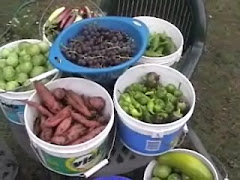
Upon occasion I awake thinking that I will be accomplishing a certain task for the day but end up consumed with everything but the originally scheduled assignment, actually more often than not. A late afternoon set aside for thinning winter garden rows and freezing peppers became an effort to wrest raspberries from wasps and amaranth seed from a flock of voracious birds.

As the second and larger crop of raspberries and strawberries start to appear on our ever bearing plants we are once again involved in the daily harvest of berries. We had not been paying too much attention to the raspberries of late but were well aware the fruit was close to being ready. I happened to take notice of them yesterday afternoon and could see that enough were ripe to be worth the effort of picking. I was hoping to get away with waiting one more day to pick as we had other chores that needed tending, but unfortunately we were not the only ones to notice that the berries were ready. A closer inspection revealed that every wasp and bald-faced hornet in the vicinity were also well aware that my berries were starting to ripen.
I have a love/hate relationship with the various types of wasps that occupy our property. On one hand they do a great service in that they eat harmful flies, caterpillars, aphids, and other insects that can be destructive to the garden. On the other hand they have quite the sweet tooth, competing with the bees for nectar and us for our fruit towards the end of summer. Hungry wasps are more likely to be a nuisance in late summer as the colony has grown exponentially and is in a frenzy to collect food, often searching out ripe fruit and other sweet things like the family barbecue.
A Bald-faced hornet nest hanging in a cedar tree next to our raspberry patch.
Normally, I leave the nests undisturbed simply taking note of where they are located, be that underground, in the above trees, or the barn and greenhouse. The small nests in the greenhouse are a great teaching tool for my grandson to learn all about various wasps and bees. He is able to watch and learn up close. I have taught him how to carefully pet the back of a bumble bee in order to see the difference in the nature of the mostly docile bee compared to the much more aggressive wasp and hornet. Late last fall he got to pick apart dormant yellow jacket and mud-dauber wasp nests, and has sat with me quietly observing as bustling bald-faced hornets moved to and fro feeding the larvae in the above nest. He has a nice little bee book that teaches him all about the mysterious inner workings of the hive and is most fascinated by the insects.
Anyway, in order to reclaim my raspberries before the wasps devoured them all "I" had to get in the patch and pick amongst them, shaking the bushes as I went along in order to dislodge any wasps that had burrowed into the berries. More often then not my wife or I end up getting stung while picking this time of the year. For the most part the wasps are as interested in the fruit as I am and we all work together trying to see who can gather the most fruit, and as long as they don't get poked in the rear with my finger they simply move around us as we pick.
This valerian plant was host to a multitude of seed hungry birds.

That same afternoon I noticed a flock of small birds hanging around my seedy valerian, Belgium endive, and amaranth plants. It didn't take long for me to realize what they were up to. Luckily, I have already collected all the valerian seed I need but had yet to focus on the amaranth and endive. So between having to unexpectedly harvest berries and seeds my afternoon was spent. Tomorrow morning I will tackle the peppers and thin my winter rows...I hope.


 Upon occasion I awake thinking that I will be accomplishing a certain task for the day but end up consumed with everything but the originally scheduled assignment, actually more often than not. A late afternoon set aside for thinning winter garden rows and freezing peppers became an effort to wrest raspberries from wasps and amaranth seed from a flock of voracious birds.
Upon occasion I awake thinking that I will be accomplishing a certain task for the day but end up consumed with everything but the originally scheduled assignment, actually more often than not. A late afternoon set aside for thinning winter garden rows and freezing peppers became an effort to wrest raspberries from wasps and amaranth seed from a flock of voracious birds.

































 Toppings for a simple pizza pie we made last week. What pizza is complete without a few peppers?
Toppings for a simple pizza pie we made last week. What pizza is complete without a few peppers?










 Anyway, I like the automatic watering system and have cut my water output by at least half, perhaps even more this year, since setting it up. Hopefully as time goes on and I become more advanced in "no water" gardening I will no longer need to use it at all, but for now it is my best solution to water conservation in the garden.
Anyway, I like the automatic watering system and have cut my water output by at least half, perhaps even more this year, since setting it up. Hopefully as time goes on and I become more advanced in "no water" gardening I will no longer need to use it at all, but for now it is my best solution to water conservation in the garden.





















